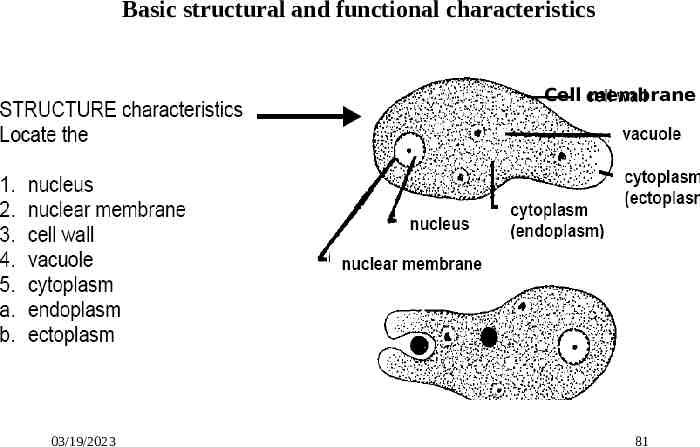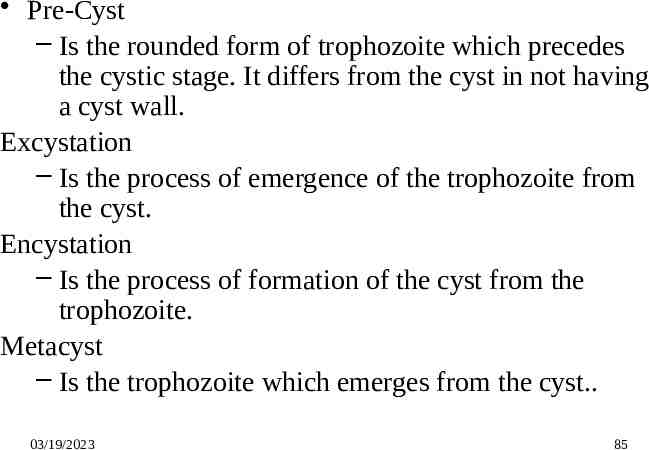Medial Parasitology II 03/19/2023 1
89 Slides3.76 MB

Medial Parasitology II 03/19/2023 1

What is medical parasitology? Hu m a n / m e d i c a l P a r Medical Protozoology Phylum Sarcomastigophora Amoeba Flagellates Phylum Apicomplexa Phylum Microsporodia Phylum Ciliophora Medical Helminthology Medical Arthropodology Class Nematoda Class Trematoda Class Cestoda Class Insecta Class Arachnida Class Crustacea Class Chilopoda 2

Parasites are our problems Six major tropical diseases to which WHO pays great attention include: Malaria, Schistosomiasis, Filariasis, Leishmaniasis, Trypanosomiasis and Leprosy. Five of them are parasitic diseases except leprosy. All the above diseases are prevalent in Ethiopia

Symbiosis Any association more or less permanent is called a symbiosis, with each member a symbiont. Two different organisms live together and interact, one partner lives in or on another one’s body. 3 types: Mutualism Commensalism Parasitism 4

Mutualism Permanent association between two different organisms that life apart is impossible, Two partners benefit each other, The mutuals are metabolically dependent on one another; One cannot survive in the absence of the other. Eg. association between certain species of flagellated protozoa(Trichonympha) living in the guts of termites 5

Commensalism – Association of two different organisms – One partner is benefited while the other neither benefited nor injured, such as E. Coli and man. Parasitism – Association of two different organisms – One partner is benefited while the other is injured, such as most pathogenic parasites and man. 6

Symbiosis severe To one Parasitism Unilateral benefit benefit harm Mutualism Commensalism, shelter & food reciprocal benefit none both partial complete dependency

Parasite and types of parasites Parasite: are organisms that live in or on the body of another living being (host) and obtain shelter and nourishment from it. parasites spend all or parts of their life with host. In parasitism, parasite is the benefited partner. In another words A small organism (Parasite) has the potential to harm a larger organism (Host), and relies on said host for nutrients and shelter (a Niche). The parasite generally has a much higher reproductive capability compared to its host. 8

Parasites can be endoparasite ectoparasite temporary parasite permanent parasite obligatory parasite facultative parasite pathogenic parasite opportunistic parasite Read their difference and similarity?

Hosts and types of hosts Host: Hosts are organisms which harbors the parasite. In parasitism, it is the injured partner Types of Hosts Definitive host Intermediate host What about other type of host?

Definitive host:– What characterizes the primary host? Where sexual reproduction takes place. Normally where the adult parasites live. Normally the larger of the hosts, usually a vertebrate. Convention - (parasites which only reproduce asexually) Only one or a few can act as a definitive host

Intermediate host:– Asexual multiplication takes place – may harbor many immature stages of a parasite; – e.g., Cercaria, Redia and Sporocysts which are all immature stages of Fasciola in the snail intermediate host. Some parasites: – require more than one intermediate host which are then designated as first, second intermediate,

INTRODUCTION TO MEDICAL PROTOZOLOGY

Lecture outcomes Identify the general characteristics of protozoans Describe the general morphology and cellular organization of parasitic protozoa Describe the locomotory and reproduction system of protozoa Explain the feeding, metabolism, and excretion in parasitic protozoa. Describe the classification of parasitic protozoa Describe the general characteristics of the five main groups and any sub-groups of the parasitic protozoa

What are Protozoa? Protozoa means proto first zoa animals Is single-celled eukaryotic organisms Belongs to kingdom Protista Vary in size (1-200 micro meter). 03/19/2023 15

Protozoan diversity protozoa are extremely diverse organisms and found in a variety of niches 200,000 named species Most species are free-living in Freshwater marine environments decaying organic matter and soil Some are beneficial to mankind by: being part of the food chain serving as experimental subjects.

Protozoan Diversity Few are adapted to a parasitic life but all plant and animal species have at least one protozoan parasite 10,000 are parasites in a wide range of hosts Vertebrate invertebrate Plants 20 human pathogens Adapted to life in a wide range of sites within the host

Ecological Niches in the Human Body: – Skin: Leishmania – Eye: Acanthamoeba – Mouth: Amoebae and flagellates (usually non-pathogenic) – Gut: Giardia, Entamoeba (and invasion to liver), Cryptosporidium, Isospora, Balantidium – Genito urinary tract: Trichomonas – Bloodstream: Plasmodium, Trypanosoma – Spleen: Leishmania – Liver: Leishmania, Entamoeba – Muscle: Trypanosoma cruzi – CNS: Trypanosoma, Naegleria, Toxoplasma, Plasmodium18 03/19/2023

Importance of protozoa Medical importance – Cause of more sickness and death, than any other disease-causing organisms – reduced working capacity – Loss of productivity Veterinary importance – Loss of productivity – Death – reduced meat and milk production, – reduced reproductive potential – reduced working capacity – Potential losses 03/19/2023 19

General morphology Protozoa exhibit a wide variety of morphologies Size: range from 1 to 150um The smaller members, 1-10um include most of the intracellular parasites e.g: Leishmania,Toxoplasma) The largest member is the ciliate e.g: Balantidium coli Shape: No single shape that represent all Ranges from amorphous shapeless amoeba to relatively rigid forms 03/19/2023 20

Structure Protozoa have relatively complex and specialized internal structure which perform: – The functions of locomotion, metabolism, and reproduction. – The same physiological functions performed by many cells in a more complex organism. These are 03/19/2023 21

Cell membrane Thin membrane called plasma lemma Also called pellicle (ciliates) or ectoderm or outer membrane Microtubules line outer membrane (subpellicular microtubules Cytoplasm Ectoplasm outer transparent layer – Locomotion, – protection – Sensation, – Excretion Ingestion of food etc Endoplasm inner granular layer – Nutrition – Reproduction etc 03/19/2023 22

Nucleus Two morphologically distinct nuclei: – Vesicular with a clearly defined internal space scattered chromatin, Karyosome – nucleoli-like body – contains DNA in apicomplexans – but lacks DNA in parasitic amoebas Most protozoa of humans exhibit the vesicular type. – Compact appears to be a solid mass densely packed chromatin 03/19/2023 23

Other structure Axostyle: – Supporting structure embedded along the longitudinal axis on the cytoplasm (some flagellates). Costa: – Rodlike structure that runs along base of undulating membrane. 03/19/2023 24

Other structure Pelta: – crescent shaped membrane in certain flagellates (Trichomonas) Cytostome or cell mouth for – ingesting fluids (flagella pocket – may serve same function) Contractile vacuoles, – Presumably for osmoregulation – (Often seen in sarcodinas and ciliates) 03/19/2023 25

Other organelles Undulating membrane 03/19/2023 Apical complex 26

Structures that mediate locomotion or 03/19/2023 27

Protozoan Reproduction 1. Asexual reproduction – Fission Division follows a sequence: organelles then nucleus then cytoplasm A. Binary fission Each parent gives rise to two progeny Transverse/longitudinal the most common form of reproduction 03/19/2023 28

Protozoan Reproduction B. Multiple fission/Schizogony Rapid organelle and nuclear divisions occur at the cell periphery. Cytoplasmic segmentation to form separate organisms called merozoites. The Parent or multinucleated cell is called the schizont or segmenter and the daughter cells are merozoites C. Endopolyogeny Daughter cells form in the center of the mother cell (internal budding). Endodyogeny is a form of endopolyogeny where two daughters are formed 03/19/2023 29

03/19/2023 30

Protozoan Reproduction 2. Sexual Reproduction A. Conjugation Specialized sexual reproduction (mostly in ciliates) Involvies nuclear exchange and union (similar to prokaryotes) after cells join 03/19/2023 31

B. Syngamy -union of the entire cell (gametes fuse) - in this process, sexually differentiated cells, called gametes, unite permanently and a complete fusion of the nuclear material takes place. The resulting product is then known as a zygote. . 03/19/2023 32

General Protozoan Reproduction Asexual Reproductions Sexual Reproductions Binary Fisión Múltiple Fisión Conjugation Singamy 03/19/2023 33

Feeding mechanisms Most parasitic protozoa are heterotrophic Procuring nutrients mostly bacteria ingest particulates (phagotrophy) Phagocytosis Engulfment of solid material predation on bacteria or other protozoa Pinocytosis Invagination of membrane surrounding

Feeding mechanisms Cytostomal feeding Food is ingested at a definite site, using a specialized feeding structure Diffusion absorb solutes (osmotrophy) through cell membrane – Food may be retained in special intracellular reserves, or vacuoles. Some protozoan are photosynthetic (autotrophy)

Excretion mechanisms Undigested particles and wastes are extruded at the cell surface by mechanisms that are the reverse of those used in ingestion – diffusion (primary mechanism) – contractile vacuole 03/19/2023 36

Respiration/Metabolism Both aerobic (Malaria) and anaerobic respiration (dysenteric amoeba) Most parasitic protozoa are facultative anaerobes They can live in reduced oxygen environments (facultative or aerotolerant anaerobes; e.g. Amoeba). In few parasitic spp studied, metabolic paths similar to all eukaryotes (bad for drug development) 03/19/2023 37

Protozoa life cycle stages/terms Most protozoa exist as Vagetative or Resístanse forms: 1. Vagetative forms: trophzotes, zoitos stage of active feeding and reproduction, & commonly the pathogenic protozoan form. Formed by asexual fission (mitosis), or also by gamete fusion in the Sporozoans. 03/19/2023 38

Protozoa life 2. Resístanse forms: cyst/oocyst – Stage of inactivity – Most resisiant stage hard to kill. – Multiplication occurs within cysts of some protozoa “excystation” releases multiples, ex. Entamoeba, giardia. 03/19/2023 39

Protozoa life cycle Standard non-Sporozoan intestinal life cycle Variations of the basic life cycle occur in members of the sporozoan classes. 03/19/2023 40

Encystation Many protozoa form cysts – round cytoplasmic mass surrounded by a rigid or semi-rigid cyst wall secreted by organism. Function: 1. Protect against unfavorable external environmental conditions. 2. Are the site for morphogenesis and nuclear division. 3. Are the infective or transmissible form of parasite. 03/19/2023 41

Conditions for encystment: loss of food source Desiccation increase in tonicity (salts) change in O2 concentration - change in pH - temperature change

Sporozoa life cycle stages/terms Oocyst: – results from fusion of gametes in the Sporozoa. – Infective stage in most cases: – passed in host feces in case of intestinal protozoans, or – in blood in gut of the mosquito vector in the case of Plasmodium. – Sporozoites form in oocyst in host via mitosis (asexual fission). 03/19/2023 43

Sporozoa life cycle stages/terms Sporozoite: special term for trophozoite in Sporozoans. Formed by mitosis within oocyst & infects new host cells; – intestinal mucosa cells in intestinal protozoans, or – hepatocytes in case of Plasmodium. Mitosis (“schizogeny”) of these cells results in formation of merozoites. 03/19/2023 44

Sporozoa life cycle stages/terms Merozoite: results from mitotic fission (schizogeny) of sporozoites. May infect same cell type as sporozoite or a different host cell: RBCs causing clinical malaria in the case of Plasmodium. can also go through meiosis to form gametes. Gametocyte: result of merozoite cell fission via Meiosis. Fusion of these results in formation of oocyst 45 03/19/2023

Why study life cycles? Control. Treatment. Epidemiology.

Protozoan Taxonomy Confused, controversial and constantly changing No universal agreement many systems & frequent changes Several bases of classification, light microscope Originally based on motility electron microscope Ultrastructural criteria used since 1960’s 4-6 phyla? In the kingdom Protista 03/19/2023 47

Molecular data can help with evolutionary relationships – Monophyletic groups Descended from common ancestor Kinetoplastids, apicomplexa, ciliates – Polyphyletic groups Multiple ancestors Amoebas and flagellates 03/19/2023 48

Taxonomic classification of protozoa Sub kingdom Phylum Protozoa Sarcomastig ophora Sub-phylum Sarcodina Genusexamples Speciesexamples Entamoeba E. histolytica Giardia G. lamblia Apicomplexa no organelle of locomotion Plasmodium P. falciparum, P. vivax, P. malariae, P. ovale Ciliophora move by cilia Balantidium B. coli Microspora Spore-forming Enterocytozoa E. bienusi further divided into move by pseudopodia Mastigophora move by flagella 49

A. Sarcodina: Pseudopod – Literally false foot. Entamoeba, Iodamoeba, Endolimax, Naegleria (CNS), Acanthamoeba (CNS) Entamoeba Trophozoite E. hystolitica 03/19/2023 50

B. The Flagellates (Mastigophora) Move by means of rotation of a whip-like organelle called a Flagellum (plural: flagella) The flagella can also be used for gathering and sorting food. Most are spindle shaped with flagella projecting from anterior end. The Outer membrane is covered with a tough pellicle.

Con. Respiration, food absorption, and excretion is performed by osmosis and active transport across the cell membrane. Some species have organelles for the purpose of food ingestion (gullet or cytostome), and for excretion (cytopyge). Encystation may be used by these organisms in response to adverse environment and/or for reproduction.

Con The parasitic members of this class are divided into two groups: The lumen flagellates, which inhabit the body orifices, the intestines and the bladder; and The blood and tissue flagellates. several genera Giardia, Chilomastix, Dientamoeba, Trypanosoma, Leishmania, Trichomonas Members pathogenic to man includes G. lamblia, T.vaginalis and species of the trypanosoma and leishmamia

IMPORTANT TERMS USED IN RELATION TO FLAGELLATES Flagellum: – An elongated hair-like organelle used for locomotion. – At ultrastructure level it reveals one pair of central tubules and nine pairs of peripheral tubules. Undulating membrane: – Is a membranous structure which connects the flagellum to the body of the parasite. – It is thrown into folds as the parasite moves, giving itan undulating appearance. Costa: – A cytoplasmic thickening seen at the

Axostyle: – A central supporting rod seen in some flagellates. Axoneme: – A delicate filament extending from the region of the kinetoplast to the cell membrane. – It represents the cytoplasmic part of the flagellum.

Giardia intestinalis Cyst 03/19/2023 Trophozoite 56

Trichomonas T. vaginalis 03/19/2023 T. intestinalis 57

03/19/2023 58

Trypanosoma 03/19/2023 59

Leishmania Amastigote 03/19/2023 Promastigote 60

C. Apicomplexans (Phylum Apicomplexa 03/19/2023 61

C. Apicomplexans (Phylum Apicomplexa) Have specialized organelles at tip (apex) of cells that penetrate host tissues. Not motile in their mature form. Obligate intracellular parasites. All are parasites(Important pathogens:) Life cycles that typically include asexual and sexual phases 03/19/2023 62

part of the life cycle occurs inside certain host cell types -usually 2 or more hosts several forms (vs only troph & cyst) some forms motile by “gliding”, hitching a ride in infected cells, etc. 03/19/2023 63

Diversity Are an extremely large and diverse group ( 5000 named species). Seven species infect humans 1. Intestinal coccidian Cryptosporidium Isospora Cyclospora 2. Blood and tissue coccidian Plasmodium Toxoplasma Babesia Sarcocystis

Plasmodium Zygote Oocyst Sporozoites Male Female Gametes 03/19/2023 Merozoites Gametocytes 65

Toxoplasma gondii (Toxoplasmosis) Bradyzoite Sporulated oocyst Oocyst Gamete 03/19/2023 Merozoite Sporocyst 66

D. Ciliates (Phylum Ciliophora) Characteristics: 1. Move and obtain food using cilia 2. Relatively rigid pellicle and more or less fixed shape 3. Distinct cytostome (mouth) Structure 4. Dimorphic nuclei, typically larger macronuclei and one more smaller micronuclei 5. some ciliates even possess an anal pore 6. Only known human pathogen is Balantidium coli 03/19/2023 67

03/19/2023 68

E. Microsporans (Phylum Mycrospora)? Obligate intracellular parasites, lack mitochondria and microtubules. Discovered in 1984 to cause chronic diarrhea and conjunctivitis, mainly in AIDS patients. 03/19/2023 69

03/19/2023 70

Intestinal protozoa 03/19/2023 72

Intestinal protozoa The most common intestinal protozoan are 1. Ameba: Entamoeba histolytica Entamoeba dispar Entamoeba coli Entamoeba hartmanni Endolimax nana Iodamoeba bütschlii 3. Apicomplexa: Cryptosporidium hominis Cryptosporidium parvum Cyclospora cayetanensis Isospora belli 03/19/2023 2. Flagellates: Giardia lamblia Dientamoeba fragilis Chilomastix mesnili Trichomonas hominis Enteromonas hominis Retortamonas intestinalis Other: Blastocystis hominis Balantidium coli 73

Common characteristics 1.Typical fecal-oral life cycle 03/19/2023 74

2. Fecal-Oral Transmission Factors intestinal protozoan transmission Water-borne epidemics Male homosexuality Oral-anal contact 03/19/2023 Zoonosis Entamoeba no Cryptosporidium yes Giardia controversial Poor personal hygiene Food handlers Institutions Children in day care centers 75

Control/prevention Improve personal hygiene Especially institutions Treat asymptomatic carriers Eg, family members Health education Hand-washing Sanitation Food handling Protect water supply Treat water if questionable Boiling Iodine Not chlorin 03/19/2023 76

Amoeba Introduction Amoeba (plural amoebae) Protists that moves by means of pseudopods Amoeba Greek word amoibe, means change Most Amoeba are free-living widely distributed mostly in -aquatic environment -fresh water, salt water, wet soil, on water plants Few of the parasitic and free-living amebas cause human disease 03/19/2023 77

General characteristics Locomotion and digestion – are accomplished by the use of the pseudopodia. – Once the food substance is contained within the cell, the organism goes through the processes of enzymatically breaking down and absorbing the nutrients. – Egestion of unused residue is performed by the expulsion of the vacuole out of the cell. 03/19/2023 78

Respiration and reproduction Respiration is performed by simple absorption of dissolved oxygen from the liquid environment. Excretion of gases and waste is performed by diffusion out of the organism through the cell membrane. Liquid regulation inside the body is controlled by Contractile vacuoles – serve as two-way pumps that control the hydrostasis between the organism and the environment. These organisms reproduce through asexual reproduction consisting of simple cell division. 03/19/2023 79

Amoeba has two forms(stage) I. Trophozoite – Motile ,actively feeding stage II. Cyst – Is the non-motile form, which is protected by a distinct membrane or a cyst wall. – This is the infective stage of most Amoeba exception are Dientamoeba fragilis and Entamoeba gingivalis 03/19/2023 80

Basic structural and functional characteristics Cell membrane 03/19/2023 81

03/19/2023 82

Pseudopod – Literally false foot. – temporary cytoplasmic processes formed at the surface of the trophozoite Ectoplasm – external hyaline portion of the cytoplasm which is generally visible in a moving trophozoite Endoplasm – Is the internal granular portion of the cytoplasm which contains various food inclusions. 03/19/2023 83

Chromatoid body – Is the RNA-protein complex which stains deeply with basic dyes but not with iodine. – It is found in the genus Entamoeba Glycogen vacuole – Is a glycogen reserve which stains deeply with iodine and is found mainly in the cysts. Food Vacuole – A membrane bound vesicle in the cytoplasm formed around an ingested food particle. Contractile vacuole – A membrane bound vesicle in the cytoplasm which collects and expels water from the cell. This is found in the free-living amoebae. Chromatin – Is the substances in the cell nucleus which stains with basic dyes. 03/19/2023 84

Pre-Cyst – Is the rounded form of trophozoite which precedes the cystic stage. It differs from the cyst in not having a cyst wall. Excystation – Is the process of emergence of the trophozoite from the cyst. Encystation – Is the process of formation of the cyst from the trophozoite. Metacyst – Is the trophozoite which emerges from the cyst. 03/19/2023 85

Taxonomy Phylum Sarcomastigophora Sub-Phylum Sarcodina Class Lobosea – Order Amoebida – Sub order Tubulina Genera: Entamoeba, Iodamoeba, Endolimax- parasitic Sub order Acanthopodina Genera: Acanthamoeba - Free living – Order Schizopyrenida Genera: Naegleria - Free living 03/19/2023 86

Classification . The Amoeba Parasitic Ameba: Intestinal Entamoeba histolytica Entamoeba dispar Entamoeba coli Entamoeba hartmanni Endolimax nana Iodamoeba bütschlii Mouth E. gingivalis 03/19/2023 Free living Ameba: Pathogenic Naegleria fowleri Acanthamoeba spp Balmuthia Mandrilarias 87

Classification . 1- pathogenic: – intestinal amoeba: E- histolytica. 2- non pathogenic: Mouth amoeba: E- gingivalis intestinal amoeba: E- coli, endolimax nana, iodamoeba butschlii 03/19/2023 88

Entamoeba histolytica History 1873.Alexandrewitch Lösch describes amoebae associated with severe dysentery in a patient He transferred amoebae to a dog by rectal injection, which became ill and showed ulceration of colon Patient who died from infection showed similar ulcers upon autopsy 03/19/2023 89







